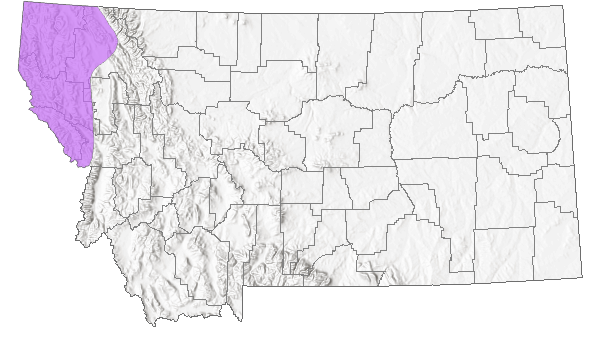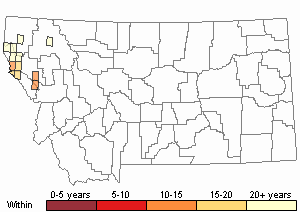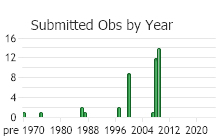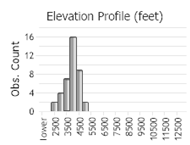View in other NatureServe Network Field Guides
NatureServe
Montana
Utah
Wyoming
Idaho
Wisconsin
British Columbia
South Carolina
Yukon
California
New York
Short-styled Thistle - Cirsium brevistylum
Native Species
Global Rank:
G5
State Rank:
S3S4
(see State Rank Reason below)
C-value:
4
Agency Status
USFWS:
USFS:
BLM:
External Links
State Rank Reason (see State Rank above)
Cirsium brevistylum occurs in northwestern Montana where it appears to occupy areas that are sunny, disturbed, and moist. It is a short-lived thistle that colonizes moist habitats disturbed from natural (gravel bars of riparian habitat; soil after a fire) or manmade (road and powerline corridors; logging units) sources, grows and reproduces for several years, and may disappear as more competitive plants establish.
- Details on Status Ranking and Review
Range Extent
ScoreF - 20,000-200,000 sq km (~8,000-80,000 sq mi)
Area of Occupancy
ScoreE - 26-125 4-km2 grid cells
Number of Populations
ScoreC - 21 - 80
Number of Occurrences or Percent Area with Good Viability / Ecological Integrity
ScoreB - Very few (1-3) occurrences with excellent or good viability or ecological integrity
Environmental Specificity
ScoreD - Broad. Generalist or community with all key requirements common
Threats
ScoreD - Low
CommentNo known threats.
General Description
Short-styled Thistle is an herbaceous perennial with thick, succulent, sparingly branched stems that are 4-25 dm high, and which arise from a taproot. The clasping, alternate leaves are pinnately lobed or toothed with spines along the margins. The foliage is thinly to densely covered with tangled white hairs. A few short-stalked flower heads are clustered at the tips of the stems. Each head is 2-4 cm high and has 2-3 series of linear, nearly non-overlapping involucral bracts, which are sparsely to densely covered with long, tangled hairs, the outermost of which have short, erect spines. There are numerous tubular, purplish red disk corollas that are 16-24 mm long. Ray flowers are lacking. The seed has a pappus.
Phenology
Flowering in June-July.
Diagnostic Characteristics
The purplish flowers and the very narrow, tapered involucral bracts without a greatly thickened midvein separate this species from the other native
Cirsium species in our area.
On first-glance thistles can look similar, but upon a closer inspection differences become apparent. Thistles belong to the genera of
Cirsium,
Carduus, and
Onopordum, which all have spiny-margined leaves and often have flower heads with spiny bracts. Ecologically, native and non-native thistles are very different.
NATIVE versus NON-NATIVE THISTLES [
Parkinson and Mangold 2015]
Native Thistles* Plants grow relatively sparsely and possess few or gentler spines, intermix with many plant species, and are slow to colonize disturbed ground.
* Flowers provide nectar and pollen for numerous native birds and insects, and forage for some wildlife. For example, elk eat the flowers of Elk Thistle.
* Involucral bracts tend to adhere to the flower head for most of their length (except for the spine).
* Plants are
not rhizomatous except for Flodman’s Thistle which can produce horizontal runner roots.
Non-native Thistles* Plants colonize disturbed ground quickly, often form dense patches, and produce nastier spines - limiting recreational activities, injuring people/animals, and reducing native plant species diversity.
* Flowers provide nectar and pollen for some birds and insects, but not forage for wildlife or livestock.
* Some species are aggressively rhizomatous and outcompete native plants that provide nutritional forage.
* Require management to control, reduce, or remove. Refer to the MANAGEMENT subsection.
DIFFERENTIATING THISTLE GENERACarduus* Stems: Winged.
* Pappus: Barbellate - minutely barbed, narrow bristles. Bristles usually fall separately.
* Flower Head - Receptacle: Not obviously fleshy or honeycombed. Densely bristly. In the flower head, look for bristles between the florets.
Cirsium* Stems: Winged or not winged.
* Pappus: Feathery (plumose) - fine, long hairs on each side of the central axis (rib).
* Flower Head - Receptacle: Densely bristly. In the flower head, look for bristles between the florets.
Onopordum* Stems: Spiny and winged along their entire length.
* Pappus: Barbellate - minutely barbed, narrow bristles. Bristles connected at base.
* Flower Head - Receptacle: Definitively fleshy and honeycombed. No or very sparse and short bristles. In the flower head, look between the florets to find nothing.
Species Range
Montana Range
Range Descriptions

 Native
Native
Range Comments
BC, MT south to CA and ID (Lesica et al. 2012. Manual of Montana Vascular Plants. BRIT Press. Fort Worth, TX).
Observations in Montana Natural Heritage Program Database
Number of Observations: 44
(Click on the following maps and charts to see full sized version)
Map Help and Descriptions
Relative Density

Recency



 (Observations spanning multiple months or years are excluded from time charts)
(Observations spanning multiple months or years are excluded from time charts)
Habitat
Meadows and disturbed forests in the valley and montane zones.
Ecology
POLLINATORS The following animal species have been reported as pollinators of this plant species or its genus where their geographic ranges overlap:
Bombus vagans,
Bombus appositus,
Bombus auricomus,
Bombus bifarius,
Bombus borealis,
Bombus centralis,
Bombus fervidus,
Bombus flavifrons,
Bombus frigidus,
Bombus huntii,
Bombus mixtus,
Bombus nevadensis,
Bombus rufocinctus,
Bombus sylvicola,
Bombus ternarius,
Bombus terricola,
Bombus sitkensis,
Bombus occidentalis,
Bombus pensylvanicus,
Bombus bimaculatus,
Bombus griseocollis,
Bombus impatiens,
Bombus insularis,
Bombus suckleyi,
Bombus bohemicus, and
Bombus flavidus (Thorp et al. 1983, Mayer et al. 2000, Wilson et al. 2010, Colla and Dumesh 2010, Colla et al. 2011, Koch et al. 2012, Williams et al. 2014, Tripoldi and Szalanski 2015).
Management
On the Lolo National Forest short-styled thistle is observed to colonize moist, open habitats that are disturbed from either manmade or natural causes. It has been observed to colonize gravel bars in riparian areas, logging units, soil after a fire, roadsides, and utility transmission lines. It seems to grow and reproduce for several years, but eventually succumbs to more competitive plants.
Stewardship Responsibility
References
- Literature Cited AboveLegend:
 View Online Publication
View Online Publication Colla, S., L. Richardson, and P. Williams. 2011. Bumble bees of the eastern United States. Washington, DC: USDA Forest Service, Pollinator Partnership. 103 p.
Colla, S., L. Richardson, and P. Williams. 2011. Bumble bees of the eastern United States. Washington, DC: USDA Forest Service, Pollinator Partnership. 103 p. Colla, S.R. and S. Dumesh. 2010. The bumble bees of southern Ontario: notes on natural history and distribution. Journal of the Entomological Society of Ontario 141:39-68.
Colla, S.R. and S. Dumesh. 2010. The bumble bees of southern Ontario: notes on natural history and distribution. Journal of the Entomological Society of Ontario 141:39-68. Douglas, G.W., G.B. Straley, D. Meidinger, and J. Pojar, editors. 1998. The Illustrated Flora of British Columbia. Volume 1. Gynmosperms and Dicotyledons (Aceraceae through Asteraceae). British Columbia Ministry of Environment, Lands and Parks and British Columbia Ministry of Forests, Victoria.
Douglas, G.W., G.B. Straley, D. Meidinger, and J. Pojar, editors. 1998. The Illustrated Flora of British Columbia. Volume 1. Gynmosperms and Dicotyledons (Aceraceae through Asteraceae). British Columbia Ministry of Environment, Lands and Parks and British Columbia Ministry of Forests, Victoria. Hitchcock, C.L. 1955. Compositae. In C.L. Hitchcock, A. Cronquist, M. Ownbey, and J.W. Thompson (eds.). Vascular Plants of the Pacific Northwest. Part 5: Compositae. Seattle, WA: University of Washington Press. 343 pp.
Hitchcock, C.L. 1955. Compositae. In C.L. Hitchcock, A. Cronquist, M. Ownbey, and J.W. Thompson (eds.). Vascular Plants of the Pacific Northwest. Part 5: Compositae. Seattle, WA: University of Washington Press. 343 pp. Koch, J., J. Strange, and P. Williams. 2012. Bumble bees of the western United States. Washington, DC: USDA Forest Service, Pollinator Partnership. 143 p.
Koch, J., J. Strange, and P. Williams. 2012. Bumble bees of the western United States. Washington, DC: USDA Forest Service, Pollinator Partnership. 143 p. Lesica, P., M.T. Lavin, and P.F. Stickney. 2012. Manual of Montana Vascular Plants. Fort Worth, TX: BRIT Press. viii + 771 p.
Lesica, P., M.T. Lavin, and P.F. Stickney. 2012. Manual of Montana Vascular Plants. Fort Worth, TX: BRIT Press. viii + 771 p. Mayer, D.F., E.R. Miliczky, B.F. Finnigan, and C.A. Johnson. 2000. The bee fauna (Hymenoptera: Apoidea) of southeastern Washington. Journal of the Entomological Society of British Columbia 97: 25-31.
Mayer, D.F., E.R. Miliczky, B.F. Finnigan, and C.A. Johnson. 2000. The bee fauna (Hymenoptera: Apoidea) of southeastern Washington. Journal of the Entomological Society of British Columbia 97: 25-31. Thorp, R.W., D.S. Horning, and L.L. Dunning. 1983. Bumble bees and cuckoo bumble bees of California (Hymenoptera: Apidae). Bulletin of the California Insect Survey 23:1-79.
Thorp, R.W., D.S. Horning, and L.L. Dunning. 1983. Bumble bees and cuckoo bumble bees of California (Hymenoptera: Apidae). Bulletin of the California Insect Survey 23:1-79. Tripoldi, A.D. and A.L. Szalanski. 2015. The bumble bees (Hymenoptera: Apidae: Bombus) of Arkansas, fifty years later. Journal of Melittology 50: doi: http://dx.doi.org/10.17161/jom.v0i50.4834
Tripoldi, A.D. and A.L. Szalanski. 2015. The bumble bees (Hymenoptera: Apidae: Bombus) of Arkansas, fifty years later. Journal of Melittology 50: doi: http://dx.doi.org/10.17161/jom.v0i50.4834 Williams, P., R. Thorp, L. Richardson, and S. Colla. 2014. Bumble Bees of North America. Princeton, NJ: Princeton University Press. 208 p.
Williams, P., R. Thorp, L. Richardson, and S. Colla. 2014. Bumble Bees of North America. Princeton, NJ: Princeton University Press. 208 p. Wilson, J.S., L.E. Wilson, L.D. Loftis, and T. Griswold. 2010. The montane bee fauna of north central Washington, USA, with floral associations. Western North American Naturalist 70(2): 198-207.
Wilson, J.S., L.E. Wilson, L.D. Loftis, and T. Griswold. 2010. The montane bee fauna of north central Washington, USA, with floral associations. Western North American Naturalist 70(2): 198-207.
- Additional ReferencesLegend:
 View Online Publication
View Online Publication
Do you know of a citation we're missing? Goeden, R.D. and D. W. Ricker. 1987. Phytophagous insect faunas of the native thistles Cirsium brevistylum, Cirsium congdonii, Cirsium occidentale, and Cirsium tioganum, in southern California. Annals Entomological Society America 80:152-160.
Goeden, R.D. and D. W. Ricker. 1987. Phytophagous insect faunas of the native thistles Cirsium brevistylum, Cirsium congdonii, Cirsium occidentale, and Cirsium tioganum, in southern California. Annals Entomological Society America 80:152-160. Lesica, P., M.T. Lavin, and P.F. Stickney. 2022. Manual of Montana Vascular Plants, Second Edition. Fort Worth, TX: BRIT Press. viii + 779 p.
Lesica, P., M.T. Lavin, and P.F. Stickney. 2022. Manual of Montana Vascular Plants, Second Edition. Fort Worth, TX: BRIT Press. viii + 779 p. Pemberton, R.W., Turner, C.E. and S.S. Rosenthal. 1985. New host records for tephritid flies (Diptera) from Cirsium and sussurea thistles (Asteraceae) in California. Proceedings of the Entomological Society of Washington. 85(4):790-794.
Pemberton, R.W., Turner, C.E. and S.S. Rosenthal. 1985. New host records for tephritid flies (Diptera) from Cirsium and sussurea thistles (Asteraceae) in California. Proceedings of the Entomological Society of Washington. 85(4):790-794. Quire, R.L. 2013. The sagebrush steppe of Montana and southeastern Idaho shows evidence of high native plant diversity, stability, and resistance to the detrimental effects of nonnative plant species. M.Sc. Thesis. Bozeman, MT: Montana State University. 124 p.
Quire, R.L. 2013. The sagebrush steppe of Montana and southeastern Idaho shows evidence of high native plant diversity, stability, and resistance to the detrimental effects of nonnative plant species. M.Sc. Thesis. Bozeman, MT: Montana State University. 124 p. Turner, C.E., R.W. Pemberton and S.S. Rosenthal. 1987. Host range and new host records for the plume moth Platyptilia carduidactyla (Lepidoptera: Pterophoridae) from California thistles (Asteraceae). Proceedings Entomological Society Washington 89(1):132-136.
Turner, C.E., R.W. Pemberton and S.S. Rosenthal. 1987. Host range and new host records for the plume moth Platyptilia carduidactyla (Lepidoptera: Pterophoridae) from California thistles (Asteraceae). Proceedings Entomological Society Washington 89(1):132-136. Turner, C.E., R.W. Pemberton, and S.S. Rosenthal. 1987. Host utilization of native Cirsium thistles (Asteraceae) by the introduced weevil Rhinocyllus conicus (Coleoptera: Curculionidae) in California. Environmental Entomology 16:111-115.
Turner, C.E., R.W. Pemberton, and S.S. Rosenthal. 1987. Host utilization of native Cirsium thistles (Asteraceae) by the introduced weevil Rhinocyllus conicus (Coleoptera: Curculionidae) in California. Environmental Entomology 16:111-115.
- Web Search Engines for Articles on "Short-styled Thistle"





